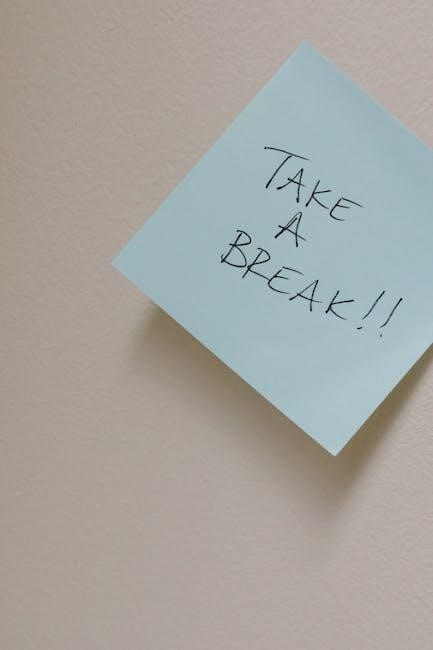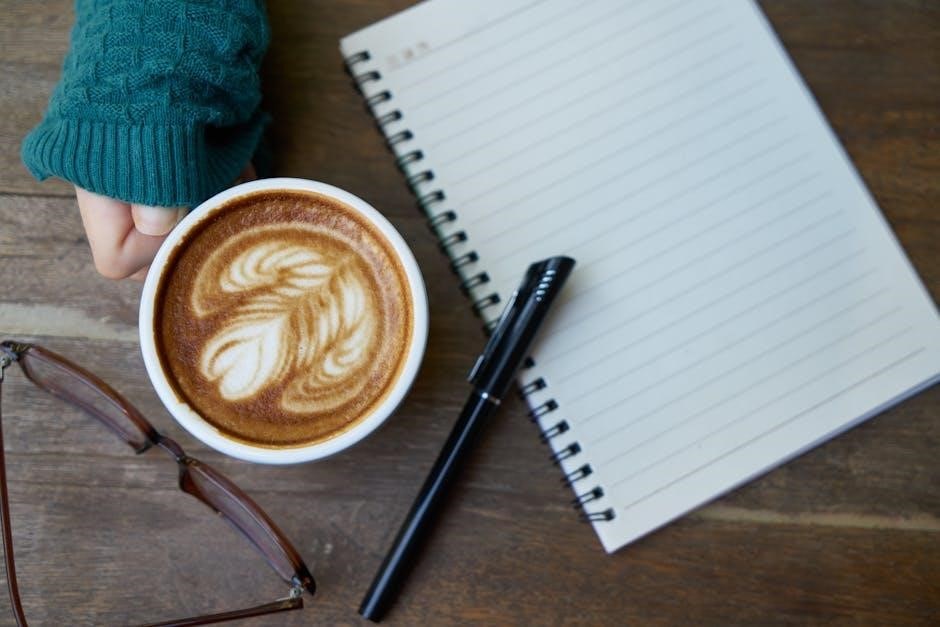
50 ways to take a break pdf
Taking breaks is essential for mental and physical well-being, boosting productivity and creativity. Discover 50 simple yet effective ways to recharge, from nature walks to mindfulness practices, ensuring a healthier lifestyle.
Why Taking Breaks is Essential for Mental and Physical Health
Taking breaks is crucial for maintaining mental and physical well-being. It helps reduce stress, prevents burnout, and improves focus. Breaks allow the mind to recharge, enhancing creativity and problem-solving skills. Physically, breaks can lower blood pressure, reduce muscle tension, and boost energy levels. Incorporating activities like deep breathing, meditation, or walking outdoors during breaks promotes relaxation and rejuvenation. Regular breaks also improve mood, reduce anxiety, and support overall health. By prioritizing breaks, individuals can achieve a better work-life balance and enhance their quality of life. Simple practices, such as journaling or listening to music, can make breaks more effective. Consistent break-taking habits foster long-term mental and physical resilience, making it a vital practice for everyone.

Categories of Break Activities
Break activities can be categorized into spending time in nature, mindfulness practices, creative pursuits, physical exercises, and relaxation techniques. These categories offer diverse ways to recharge.
Spending Time in Nature
Spending time in nature is a refreshing way to take a break. Activities include walking in parks, sitting by a body of water, or simply gazing at clouds. Nature helps clear the mind and reduce stress. Taking a moment to connect with the outdoors can rejuvenate your spirit and provide a sense of calm. Whether it’s a quick stroll or a longer hike, nature offers endless opportunities to step away and recharge. This simple yet powerful practice is one of the 50 ways to take a break, promoting well-being and fostering a deeper connection with the environment.
Mindfulness and Relaxation Practices
Mindfulness and relaxation practices offer a calming way to recharge. Activities like taking deep belly breaths, meditating, or listening to guided relaxation can help clear the mind. These practices promote mental clarity and reduce stress. Writing in a journal or simply sitting in silence also fosters self-reflection and emotional balance. Mindfulness allows you to focus on the present moment, creating a sense of peace. Whether through breathing exercises or quiet reflection, these practices provide a powerful way to unwind and rejuvenate. They are simple yet effective methods to incorporate into your daily routine for better well-being. Mindfulness and relaxation are essential components of the 50 ways to take a break, helping you return to tasks with renewed energy and focus.
Creative and Fun Activities
Creative and fun activities are excellent ways to take a break and recharge. Singing a song, dancing, or engaging in a hobby like drawing or coloring can uplift your mood. Trying something new, like learning a quick skill or crafting, adds excitement to your downtime; These activities stimulate your imagination and provide a sense of accomplishment. Even simple acts like daydreaming or smelling flowers can spark joy. Creative breaks help shift your focus away from stress, fostering a more positive mindset. They allow you to express yourself and explore new interests, making breaks both refreshing and fulfilling. Incorporating fun and creativity into your downtime ensures a well-rounded and enjoyable experience, keeping your mind active and inspired.

Physical Activities for Breaks
Physical activities like running, biking, or walking are great for refreshment. Even climbing a tree or stretching against a wall can energize and clear your mind during breaks.
Going for a Run
Going for a run is an excellent way to recharge and refresh your mind and body. It allows you to explore new places, breathe fresh air, and boost your energy levels. Running can be done anywhere, whether in a park, on a trail, or even in your neighborhood. The rhythmic movement helps clear your thoughts and reduces stress. Varying your route or pace can keep it engaging and prevent monotony. Remember to stretch before and after to avoid discomfort. Even a short 10-minute run can make a significant difference in your mood and productivity. Incorporating running into your break routine is a simple yet effective way to stay active and mentally sharp.
Taking a Bike Ride
Taking a bike ride is a refreshing and invigorating way to take a break. It combines physical activity with the freedom to explore new environments, whether it’s a scenic trail, a park, or a quiet neighborhood street. The rhythmic pedaling can help clear your mind and reduce stress, while the fresh air and movement boost your energy levels. Bike rides are versatile and can be tailored to your mood—whether you prefer a leisurely pace or a more intense workout. They also offer an opportunity to disconnect from screens and reconnect with nature and your surroundings. Even a short ride can leave you feeling rejuvenated and ready to tackle tasks with renewed focus. Incorporating bike rides into your break routine is a simple yet effective way to refresh your mind and body.

Walking Outside
Walking outside is a simple yet powerful way to take a break and refresh your mind. It allows you to connect with nature, breathe in fresh air, and step away from the confines of your daily routine. Even a short walk can help clear your thoughts, reduce stress, and boost your mood. You can walk at a leisurely pace to enjoy your surroundings or pick up the speed for a more invigorating experience. Walking outside also provides an opportunity to practice mindfulness by paying attention to the sights, sounds, and smells around you. Whether it’s strolling through a park, exploring a new neighborhood, or simply circling your block, walking outside is an accessible and effective way to recharge and return to your tasks with renewed energy and focus.
Relaxation Techniques
Relaxation techniques offer a serene escape from stress, promoting mental calm and physical ease. Activities like napping, lighting candles, or listening to music help unwind and recharge effectively.

Taking a Nap
Taking a nap is a simple yet powerful way to recharge. A short nap can improve alertness, memory, and mood, while longer naps support deeper relaxation and recovery. According to the 50 Ways to Take a Break guide, napping is a popular method for mental and physical rejuvenation. It’s recommended to keep naps under 30 minutes to avoid grogginess. Create a restful environment by dimming lights and minimizing noise. Napping can be done anywhere, from home to work, making it an accessible and effective break activity. Incorporate napping into your routine to enhance productivity and overall well-being, as suggested by various relaxation techniques.
Lighting a Candle and Resting
Lighting a candle and resting is a serene way to unwind and recharge. This activity creates a calming atmosphere, helping you disconnect from stress. The soft glow and soothing scent of a candle can induce relaxation, clearing your mind. According to the 50 Ways to Take a Break guide, this practice is ideal for mindfulness and self-care. Find a quiet space, light a candle, and sit comfortably, focusing on your breath. Allow yourself to let go of tension and immerse in the peaceful moment. Even a short period, like 10–15 minutes, can refresh your mind and body. This simple yet effective method promotes emotional balance and prepares you to tackle tasks with renewed energy and clarity.
Listening to Music
Listening to music is a powerful way to unwind and recharge during a break. It allows you to distract your mind from stress and immerse yourself in calming or uplifting melodies. The 50 Ways to Take a Break guide highlights music as a versatile tool for relaxation. Choose your favorite playlist, nature sounds, or instrumental tracks to create a soothing atmosphere. This activity helps reduce tension, lowers stress levels, and rejuvenates your spirit. You can also combine it with other relaxation techniques, such as closing your eyes or taking deep breaths, to enhance the experience. Music’s universal appeal makes it an accessible and enjoyable way to take a break, no matter your mood or preference.
Mindfulness and Reflection
Mindfulness and reflection are key to mental clarity and emotional balance. Activities like meditating, deep breathing, and journaling help you reconnect with yourself, fostering self-awareness and calm.
Meditating
Meditating is a powerful way to clear your mind and reduce stress. By focusing on your breath or a mantra, you can achieve a state of calm and clarity. Even just a few minutes of meditation can help you recharge and gain perspective. Find a quiet space, sit comfortably, and let go of distractions. Regular meditation improves focus, emotional balance, and overall well-being. It’s a simple yet effective practice to incorporate into your daily routine for a healthier, more centered life.
Taking Deep Belly Breaths
Taking deep belly breaths is a simple yet effective way to relax and recharge. By focusing on slow, intentional breathing, you can calm your mind and reduce stress. Sit or stand comfortably, inhale deeply through your nose, allowing your belly to rise, and exhale slowly through your mouth. This practice helps lower your heart rate, improve oxygen flow, and clear your thoughts. Regular deep breathing can enhance focus, reduce anxiety, and promote overall well-being. It’s a quick and accessible method to take a break anywhere, anytime, making it an excellent addition to your self-care routine for a more balanced and centered life.
Writing in a Journal
Writing in a journal is a therapeutic and reflective way to take a break. It allows you to process emotions, organize thoughts, and gain clarity. By setting aside time to write without editing or judgment, you can express yourself freely. This practice fosters mindfulness, helping you stay present and reduce stress. Journaling can also serve as a creative outlet, where you can document memories, goals, or gratitude. Over time, it becomes a valuable record of personal growth and self-reflection. Whether you write a few sentences or several pages, journaling provides a meaningful way to pause, reflect, and recharge, making it a powerful tool for mental well-being and self-care.
Leave a Reply
You must be logged in to post a comment.